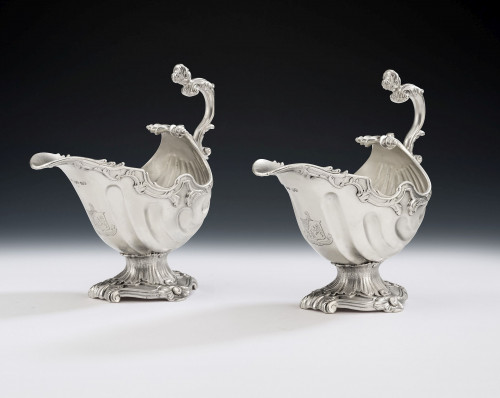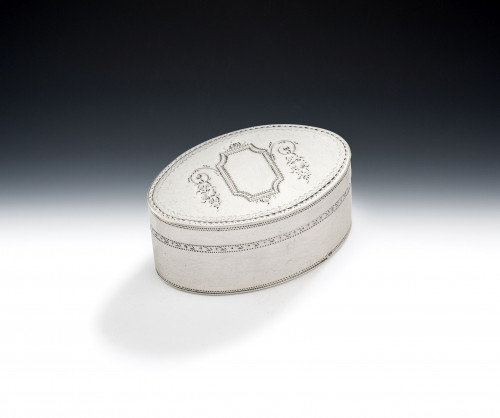- Home
- British Silver Post 1830
- A very fine pair of William IV Soap Boxes made in London in 1836 by Archibald Douglas.
A very fine pair of William IV Soap Boxes made in London in 1836 by Archibald Douglas.
A very fine pair of William IV Soap Boxes made in London in 1836 by Archibald Douglas.
375432
The Soap Boxes have a broad rectangular form with cut glass square base. The beautiful pull off covers display an outer rim of scrolls and flower heads. The central panel is decorated with engine turned designs around a section pierced and engraved with beautiful foliate scrolls . The centre displays a circular button cartouche engraved with an unusual contemporary Crest. Archibald Douglas specialised in silver mounted glass pieces used when travelling and these are acknowledged as boxes which would be used for containing soap, the pierced covers making sure that the soap did not dry out. Both are of the finest quality and in quite excellent condition.
The very unusual Crest is that of Pellew. The Pellew family were of Norman origin but were settled in Cornwall by the 16th century. Like many Cornish families the Pellews had a maritime focus- the first to come to major prominence was Edward Pellew (1757-1833) who joined the Royal Navy in 1770 and rose through the ranks to reach Post Captain in 1782. In 1793 he captured the Cleopatra, a French frigate of 63 guns, and received his knighthood. In 1796 Edward was created a baronet and, unusually, the crest he chose was very specific- it depicts the wrecking of the Dutton, a ship of the East India Company, off Plymouth in 1796. The rescue of the ship's crew, at significant personal risk, was one of Pellew's greatest triumphs. When he retired from active service in 1821 Pellew had served in many theatres of war- including being Commander in chief of the East Indies from 1804 to 1809, of the North Sea in 1810 and of the Mediterranean from 1811 to 1816. He was created a Knight Commander of the Bath in 1815, Grand Cross of the Bath in 1816 along with decorations from Spain, Naples, the Netherlands and Savoy. In 1814, the same year he was made a full Admiral, Pellew was also created Baron Exmouth and granted a pension of £2,000 per year (to be inherited by the heirs to the title). This was followed by a Viscountcy of the same name in 1816. As he died in 1833, the Crest is that of his son Admiral Sir Fleetwood Broughton Reynolds Pellow CB KCH (13 December 1789 – 28 July 1861) who was a Royal Navy officer involved in the French Revolutionary and Napoleonic Wars. Fleetwood received his first command when he was just 17, but seemed to justify it with his gallantry and daring, which won him the admiration of his father. Fleetwood's doting father helped him rise through the ranks. He was given a knighthood and was appointed a Knight Commander of the Royal Guelphic Order in January 1836, so may well have commissioned certain items of silver to celebrate this. He was made a naval aide-de-camp to Queen Victoria, promoted to rear-admiral on 9 November 1846, and in December 1852 he finally returned to active service with his appointment as commander-in-chief of the East Indies and China Station.
Length: 3.8 inches, 9.5 cm.
Width: 2.5 inches, 6.25 cm.
Height: 1.5 inches, 3.75 cm.
Thank you for your enquiry.
We will get back to you soon.
Please create wishlist to add this item to
RELATED ITEMS


























